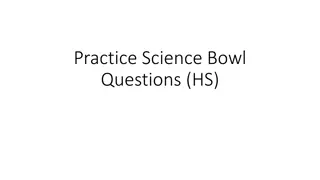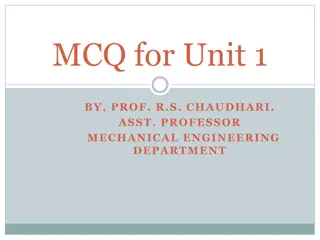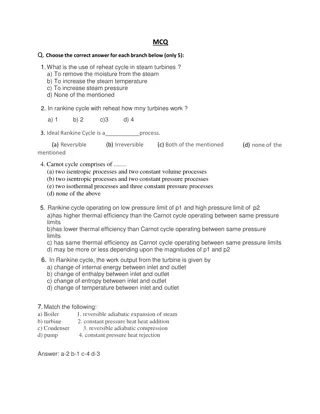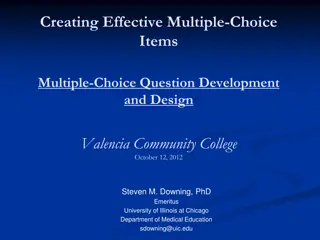Multiple choice questions
Mycobacterium tuberculosis, the bacterium causing TB, was discovered by Robert Koch. Learn about MDR and XDR TB, transmission methods, and tubercular granulomas formed in infected tissues. Understand the incorrect statements regarding TB exposure and development.
Download Presentation

Please find below an Image/Link to download the presentation.
The content on the website is provided AS IS for your information and personal use only. It may not be sold, licensed, or shared on other websites without obtaining consent from the author.If you encounter any issues during the download, it is possible that the publisher has removed the file from their server.
You are allowed to download the files provided on this website for personal or commercial use, subject to the condition that they are used lawfully. All files are the property of their respective owners.
The content on the website is provided AS IS for your information and personal use only. It may not be sold, licensed, or shared on other websites without obtaining consent from the author.
E N D
Presentation Transcript
Multiple choice questions Mycobacterium tuberculosis
The scientist who discovered M. tuberculosis was: A: Louis Pasteur B: Robert Koch C: Jean-Antoine Villemin D: Calmette and Guerin Correct answer: B
MDR TB: is defined as resistance to A: more than three anti tubercular drugs B: isoniazid and rifampin irrespective of resistance to any other drug C: INH, PZA and Rifampicin D: fluoroquinolones and at least one of the three injectable second-line drugs used to treat TB Correct answer: B
XDR TB is defined as A: MDR TB that also is resistant to fluoroquinolones and at least one of the three injectable second-line drugs used to treat TB (amikacin, kanamycin, or capreomycin) B: resistant to two most effective first-line therapeutic drugs, isoniazid and rifampin irrespective of resistance to any other drug C: MDR TB that is resistant to either one of the injectable second line drugs or second-line therapeutic fluoroquinolones D: Strain resistant to more than one drug (excluding co resistance to INH and rif) Correct answer: A
Tuberculosis is transmitted through: A: Infected water B: Infected hands C: Infected blood D: Infected air Correct answer: D
Which of the following statements is incorrect: A: People who are exposed to TB may or may not develop TB infection B: People with TB infection may or may not develop TB disease C: risk of developing TB disease is highest in first 2 years after infection D: Every individual exposed to TB develops disease Correct answer: D
Tubercular Granulomas are made up of: A: organized aggregates of immune cells that surround foci of infected tissues B: Damaged tissue cells and bacilli only C: Fibrous and damaged tissue and bacilli only D: Necrotic tissue and damaged tissue and bacilli only Correct answer: A
Cord growth seen on mycobacterial culture is characteristic of: A. Avirulent strains B. Virulent strains C. Saprophytic strains D. Atypical mycobacteria Correct answer: B
Which one of the following are constituent of Lowenstein Jensen media except: A. Agarose B.Malachite gree C. Mineral salts D. Asparagine Correct answer: A
Following are the first line antitubercular drugs except: A. isoniazid B. rifampin C. PAS D. streptomycin Correct answer: C
Which one of the following anti-tubercular drugs acts best in acidic pH: A. INH B. Pyrazinamide C. Streptomycin D. Rifampicin Correct answer: B
Mutations in katG gene of Mycobacterium tuberculosis are responsible for resistance to: A. INH B. Rifampicin C. Pyrazinamide D. Streptomycin Correct Answer: A
Which of the following tests are banned for diagnosis of tuberculosis: A. Culture B. ELISA C. PCR D. LPA Correct result: B
Which of the following statements is incorrect: A. Mycobacteria are obligate aerobes B. Increased CO2tension enhances growth C. Can not grow in cell free media D. Doubling time of tubercle bacilli is about 18 hours. Correct answer: C
One word answer Identify the stain ZN stain Identify the organism M. tuberculosis Describe the morphology Acid fast, Long slender, curved, bunch, beaded
True/ False For people with TB infection and no risk factors, the risk is about 5% in the first two years T For people with TB infection and no risk factors, the risk is about 10% over a lifetime T For people with TB infection and diabetes, the risk is about 30% over a lifetime T For people with TB infection and HIV infection , the risk is about 7% to 10% over a lifetime F
Which one of the following is a non cultivable mycobacteria: A. M. tuberculosis B. M. Bovis C. M. leprae D. M. avium intracellulare Correct Answer: C
Which one of the following is a rapid grower mycobacteria: A. M. scrofulaceum B. M. kansasii C. M. fortuitum D. M. avium intracellulare Correct Answer: C
Buruli ulcer is caused by: A. M. tuberculosis B. M. ulcerance C. M. marinum D. M. chelonei Correct answer: B
Swimming pool granuloma is caused by: A. M. tuberculosis B. M. ulcerance C. M. marinum D. M. chelonei Correct answer: c
Most common cause of disseminated opportunistic infection in AIDS patients in western world is: A. M. avium intracellulare complex B. Pneumocystis carinii C. Cryptosporidium D. Zygomycetes Correct answer: A
Gerhard Henrik Armauer Hansen,s contribution to Microbiology was; A. First identified M. leprae as the cause of leprosy in 1873 B. First identified M. tuberculosis as a cause of TB in 1895 C. First identified B. anthracis as a cause of Anthrax in 1872 D. First identified that small pox is a contagious disease Correct Answer: A
Which of the following description suits lepra bacilli best: A. acid-fast rod-shaped organism with parallel sides and rounded ends, mostly extracellular, often grouped together like bundles of cigars B. acid-fast rod-shaped organism with parallel sides and rounded ends, chiefly in masses within the lepra cells (globi), often grouped together like bundles of cigars or arranged in a palisade C. acid-fast rod-shaped organism with parallel sides and rounded ends, chiefly intracellular in Chinese letter form D. acid-fast rod-shaped organism, extracellular, Chinese letter form Correct answer: B
An adult male is presenting with hypo-pigmented patches on forearm, partial loss of cutaneous sensations in affected areas, presence of thickened ulnar nerve and presence of AFB in nasal smears. Your diagnosis is: A. Cutaneous Tuberculosis B. Leprosy C. Atypical mycobacteriosis D. Actinomycosis Correct answer: B
A case of leprosy with good Cell mediated immunity usually presents as following form of disease: A. Lepromatous B. Tuberculoid C. indeterminate D. Borderline Correct answer: B
Erythma nodosum leprosum as seen in patients of leprosy on treatment, is due to: A. Type I hypersensitivity reaction B. Type II hypersensitivity reaction C. Type III hypersensitivity reaction D. Type IV hypersensitivity reaction Correct answer: C
Presence of sulfur granules in pus is pathognomonic of: A. Subcutaneous mycosis B. Leprosy C. Actinomycosis D. Cutaneous Tuberculosis Correct Answer: C
There is a 30 year old male presenting with lumpy jaw, suppurative inflammation and formation of multiple abscesses and sinus tracts with discharge of pus containing sulfur granules. Most probable clinical diagnosis is; A. Leprosy B. Actinomycosis C. Subcutaneous mycosis D. Cutaneous TB Correct Answer: B
There is a 30 year old male presenting with lumpy jaw, suppurative inflammation and formation of multiple abscesses and sinus tracts with discharge of pus containing sulfur granules. Following types of microscpic examinations can be ordered to confirm the diagnosis, except; A. Smear examination for Gram positive bacteria B. Microscopic examination of Crush smear of granule C. Smear examination for acid fast bacilli D. KOH mount Correct answer: D
There is a 30 year old male presenting with lumpy jaw, suppurative inflammation and formation of multiple abscesses and sinus tracts with discharge of pus containing sulfur granules. Best therapy in this case will be: A. Antitubercular drugs B. Aminoglycosides C. Penicillin D. Co trimoxazole Correct Answer: C
Which one of them is non acid fast: A. Mycobacterium tuberculosis B. Nocardia C. Actinomyces D. Mycobacterium leprosy Correct Answer: C























